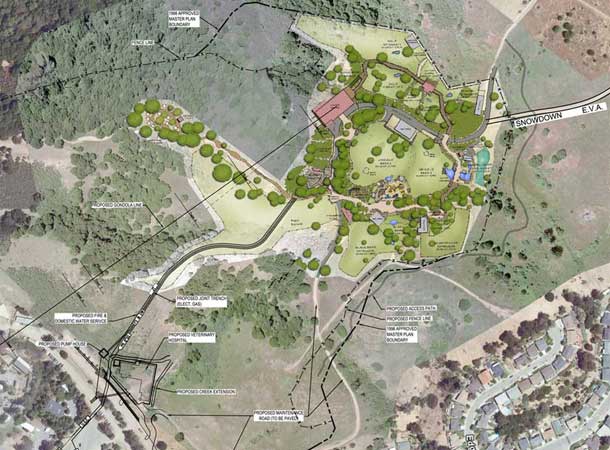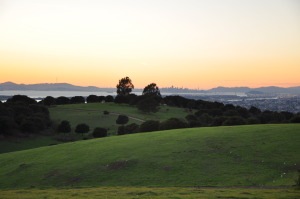The Oakland Zoo sits at the edge of Interstate 580, occupying the western corner of Knowland Park. At 45 acres, the zoo makes up less than one tenth of the park’s overall area. But a plan to double that ratio has been in place since 1998, when the Oakland City Council approved a proposed expansion. Now, though ground has yet to be broken on the work itself, the project has retaken center stage thanks to a controversy over recent amendments. A final decision, expected from the Planning Commission on March 16, has been postponed to April 20.
“We have made some changes that we think are better for the environment, that make sense from a visitor flow and animal perspective,” says Nik Haas-Dehejia, project director of the zoo’s expansion plan. Those changes include replacing a proposed shuttle bus route with an aerial gondola, enlarging a proposed visitor center, and building a new veterinary hospital.
But some disagree with Haas-Dehejia’s characterization of the amendments. “There’s no question that it’s going to fence off open space, and it’s going to be visible and audible in other areas of the park,” says Stefanie Gandolfi, a member of the advocacy group Friends of Knowland Park. She has helped run the organization’s campaign to scale back the zoo’s expansion plan.
Recently those efforts have focused on the city’s environmental review of the updated project. The Department of Planning and Zoning has not requested a full Environmental Impact Report, stating that the changes to the original plan are too minor to require one. Instead, it released what’s officially called a Subsequent Mitigated Negative Declaration/Addendum report in February, which evaluates the project’s effects on air quality, biological resources, and other environmental areas.
But Gandolfi says that isn’t enough. “Friends of Knowland Park and a bunch of other groups and individuals are claiming that a whole bunch of changes have taken place, and that a full review is required,” she says. “Our position is that the treatment has been too cursory up to now.”
Among other concerns, Friends of Knowland Park believes the city planning department did not consider new information about the area’s biological diversity. “More than a decade has passed since that first review,” says Gandolfi. “We know a lot more about the species that are in the park.”
A 2009-2010 survey found a previously undetected native wildflower on the site of a proposed wolf enclosure. Though not a state or federally endangered species, the plant, bristly leptosiphon, is included in the California Native Plant Society’s Inventory of Rare and Endangered Plants. Mitigation measures proposed by the negative declaration report, which include building a fence around the plant population, have not satisfied Friends of Knowland Park.
The group has additionally pointed to the proliferation of sudden oak death and the sighting of a federally threatened Alameda whipsnake on the proposed expansion site as examples of insufficiently accounted for data.
But Haas-Dehejia says the zoo has done a thorough impact analysis. “We rely on the city to determine the adequacy of the document,” he says. “But based on the extensive work that’s been done, we believe that it has been thoroughly reviewed.”
Still, the Planning Commission received so many comments on the negative declaration report that it voted to postpone its final decision from March 16 to April 20. Haas-Dehejia says the zoo is taking this time to look at some of the feedback. “One of the things we are doing right now is reviewing a lot of the public comments that were submitted,” he says. “Is there anything that we can learn from these comments that we haven’t heard in the past?”
For its part, Friends of Knowland Park has taken the delay as an opportunity to step up its campaign. The group’s website encourages citizens to ask for a full EIR by calling city council representatives or writing letters to the editor.
Gandolfi admits that the group has ambitious hopes for a full EIR. “Our goal would be to move the expansion off the hill,” she says. Currently the zoo sits mostly on flat land, but the growth would encompass more of the park’s elevated terrain. “The existing zoo is sort of down in a pocket, in a basin at the bottom of the park,” explains Gandolfi. “It’s insulated visually and sound-wise from surrounding communities. What the zoo is proposing now is extending the zoo up the hillside to the ridgeline, so it’ll be dramatically higher in the landscape.”
But Haas-Dehejia says this intention predates the amendments. “We were always going to be on that plateau,” he says. The approved 1998 plan not only called for developing the hill, but also projected a larger area than the updated version. “There’s some misinformation out there that we’ve made the project larger,” says Haas-Dehejia. “In fact, we’ve made it smaller. It was roughly 62 acres, and now it’s 56.”
Friends of Knowland Park claims that the enlarged visitor center and aerial gondola will affect park users’ views more than the original project suggested. But Gandolfi concedes that the group’s objections exceed the scope of the current amendments. “The whole thing needs to be reevaluated,” she says.
Haas-Dehejia maintains that the expansion is not only environmentally sound, but will inspire greater respect for nature. Most of the enlarged area will encompass a California exhibit, introducing visitors to native plants and animals. “We feel there’s real value and benefit to what the story is to this project,” he says. “It’s about that moment of inspiration when you get connected. It creates a lifelong advocate and hopefully a conservationist.”
In the end, then, both sides assert that they have nature’s best interest in mind. “We actually have very much the same goals,” says Haas-Dehejia. “Protecting and preserving Knowland Park.”
You can download the entire negative declaration document here (item 12 near bottom). Through April 20, comments can be emailed to the case manager, dranelletti@oaklandnet.com, faxed to Darin Ranelletti at (510) 238-6538, or sent via postal mail (or delivered in person) to Darin Ranelletti, Planner III, City of Oakland Community & Economic Development Agency, 250 Frank Ogawa Plaza, ste. 3315, Oakland, CA 94612.

.jpg)

